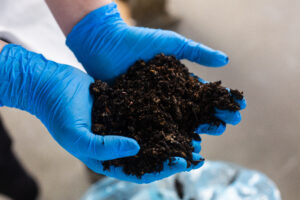Fixing Food Waste with Packaging Innovation
Only two-thirds of food grown makes it to the consumer, at which point up to half of what’s left goes to waste. Innovation in food packaging is an effective way to tackle food waste, as extending shelf life of a product reduces waste throughout the supply chain. We spoke to two innovative companies to understand more about the market: Apeel Sciences and Food Freshness Technology.
We discovered that there are three significant drivers for innovation in packaging. The first is reducing waste throughout the supply chain, increasing profit for growers (who take the largest risk). The second is delivering more predictable, higher quality, and safer products for retailers. The third driver is related to transportation; improved packaging enables slower, less expensive (sea vs air) transport.
To protect fresh produce, you have to reduce exposure to air, prevent oxidation, or reduce environmental changes. This can either be done by a barrier between air and fruit, by removing oxidation chemicals, or controlling the transportation environment. The most effective solutions are those that travel with the fruit and can combat spoilage regardless of environmental changes.
Food Freshness Technology does this by introducing a chemical to the container itself that absorbs ethylene, the chemical trigger for ripening. A proprietary, palladium-based powder is either integrated into the absorbent pads, or a small pad is added to the packaging alongside the produce.
Apeel Sciences is developing a coating for fruit based on natural ingredients that mimic fruit skins, protecting the fruit from losing moisture and absorbing oxygen. Coatings are not new – think of waxed lemons – but the natural, edible, chemical-free ‘second skin’ from Apeel is attracting investor attention (the company just raised $70 million from Viking Global, Andreessen Horowitz, UpFront Ventures, and S2G Ventures).

Business Model
Changing the way food is packaged or transported requires coordination of producers, wholesalers, distributors, and retailers. The fastest way to enter the supply chain is to work with a retailer and integrate a product within their supply chain. Food Freshness Technology employs this model and has a variety of arrangements where a retailer may buy their ethylene absorbing pads directly and then sell on to their supply chain, or the retailer will work with FFT to integrate their product into the supply chain, usually at the packing-house stage.
Apeel Sciences works differently. The company contracts with both retailer and producer. A deal, such as with Costco, sees the retailer buying coated avocados from Apeel, with Apeel then contracting with a producer and pack-house to supply the coated avocados. This means Apeel never ‘owns’ the fruit, but takes responsibility for sourcing it, adding value with their product, and selling on.
Growth Plans
For Apeel Sciences the focus is on ramping up operations. Their product is a coating, and therefore requires a degree of technical integration with supply chain machinery and systems. The company is also working on coatings for citrus, berries, stone fruit, and asparagus to expand on their success in avocados.
Food Freshness Technology is a holding company, selling their ethylene absorbing pads through the name It’s Fresh!. The company is focusing on what it terms the Freshasphere™, innovations that delivery extra quality and value for the fresh produce industry. This involves working to protect produce from other harmful chemicals, fungi, pollution, etc. that affect fresh produce. Other innovators are trying to tackle this through a packaging solution, but Food Freshness Technology aims to offer a solution that does not rely on one type of packaging to control the environment.
Competition
The packaging industry is evolving quickly, with both companies interviewed mentioning that there is space for several solutions that will include coatings, controlled environments, chemical absorbents, and more including the following three solutions we have seen raising capital this year. Bluwrap, an alternative to polystyrene and ice, uses a fuel cell technology to reduce and monitor oxygen, which extends the shelf life of proteins by up to 40 days. Wheatsheaf, who originally invested in Bluwrap in 2014, provided additional growth funding in June 2018. TemperPack is developing a fully recyclable insulated carton box that keeps a constant temperature for perishables such as food and medication, and brought in Closed Loop Partners in a $4.5 million round in July. Hazel Technologies develops a similar product to Food Freshness Technology, and adds a sachet to fresh produce to remove ethylene. The company raised a $3.26 million Series A in February from S2G Ventures and 4 others.
If you have feedback, or would like to dive into this discussion with me personally, please get in touch at chris.sworder@cleantech.com.


